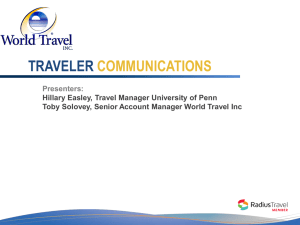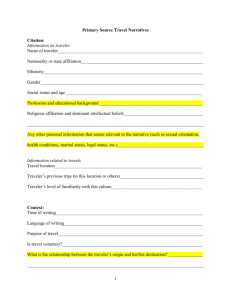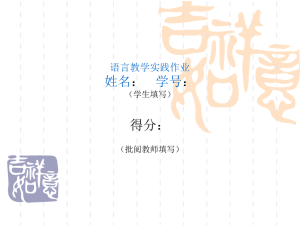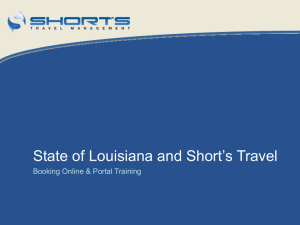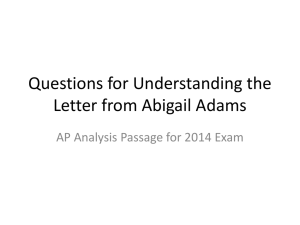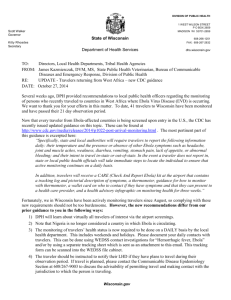Excellent Adventures in Old World Encounters 2011
advertisement
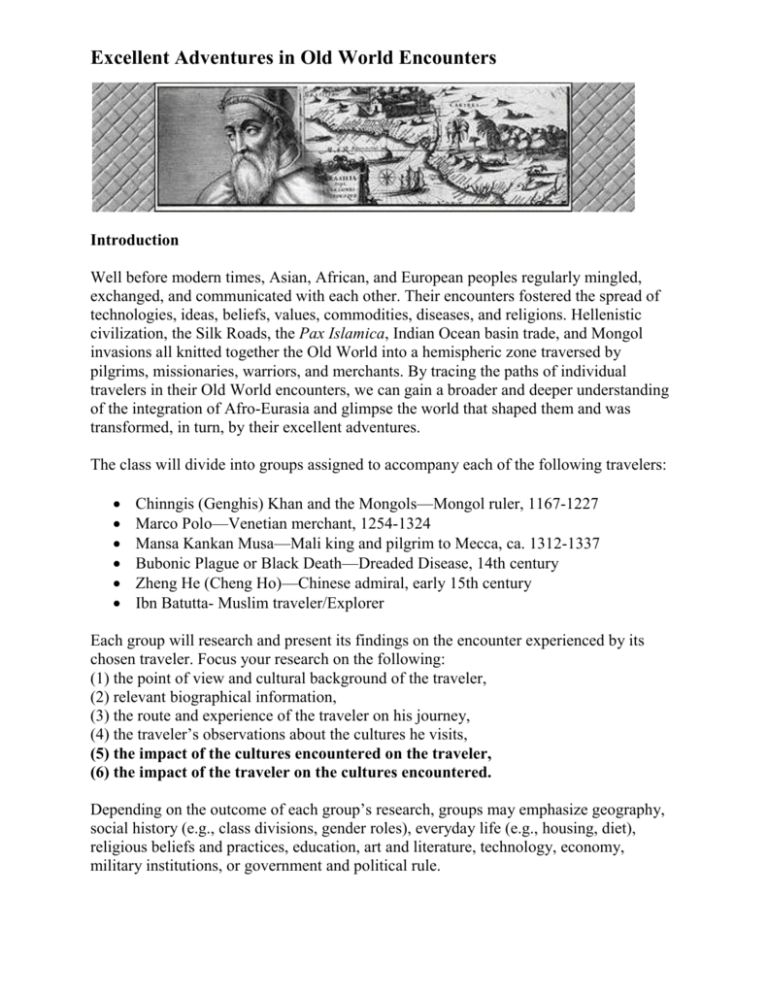
Excellent Adventures in Old World Encounters Introduction Well before modern times, Asian, African, and European peoples regularly mingled, exchanged, and communicated with each other. Their encounters fostered the spread of technologies, ideas, beliefs, values, commodities, diseases, and religions. Hellenistic civilization, the Silk Roads, the Pax Islamica, Indian Ocean basin trade, and Mongol invasions all knitted together the Old World into a hemispheric zone traversed by pilgrims, missionaries, warriors, and merchants. By tracing the paths of individual travelers in their Old World encounters, we can gain a broader and deeper understanding of the integration of Afro-Eurasia and glimpse the world that shaped them and was transformed, in turn, by their excellent adventures. The class will divide into groups assigned to accompany each of the following travelers: Chinngis (Genghis) Khan and the Mongols—Mongol ruler, 1167-1227 Marco Polo—Venetian merchant, 1254-1324 Mansa Kankan Musa—Mali king and pilgrim to Mecca, ca. 1312-1337 Bubonic Plague or Black Death—Dreaded Disease, 14th century Zheng He (Cheng Ho)—Chinese admiral, early 15th century Ibn Batutta- Muslim traveler/Explorer Each group will research and present its findings on the encounter experienced by its chosen traveler. Focus your research on the following: (1) the point of view and cultural background of the traveler, (2) relevant biographical information, (3) the route and experience of the traveler on his journey, (4) the traveler’s observations about the cultures he visits, (5) the impact of the cultures encountered on the traveler, (6) the impact of the traveler on the cultures encountered. Depending on the outcome of each group’s research, groups may emphasize geography, social history (e.g., class divisions, gender roles), everyday life (e.g., housing, diet), religious beliefs and practices, education, art and literature, technology, economy, military institutions, or government and political rule. Tasks I’m asking you to imitate the director of Bill and Ted’s Excellent Adventure by posing as Time Travelers who accompany your assigned traveler on his excellent adventures. Your goal is to understand (and relate to your classmates) how your traveler fit into the Old World system. 1. Informational packet. These packets should be clearly organized. You should compile this packet in class as a group. (Due Tuesday, December 20th) a) An annotated timeline representing major events in your traveler’s life, encounter, and the impact of the encounter. Do not produce a long list of dates without knowing how and why they were important. You must decide on a good place to begin and a good place to end. Your entries on the timeline should be there for a specific purpose. You know you have chosen a good date if you can answer the question "So what?" about it. You should include dates external to the life of the traveler that, none-the-less, would affect his life. b) A primary source document from a time and place you visited, an analysis guide, and an introduction to the primary source. You are expected to include your classmates in a discussion about the significance of your traveler. These texts will help your classmates participate. Be sure to provide enough background information to help your classmates understand the document. This information can be in the form of a secondary source that you excerpt and include in the homework packet, or a short essay that your group composes to explain context. The analysis guide should help your classmates interpret the document itself. I will derive questions for the final based on this source. c) An annotated bibliography that gives all the usual information about the publication of the sources you consulted, plus a few sentences about its usefulness or limitations for the project. The goal is to give your classmates some idea about what they might expect to find in this source. This bibliography will also be included in the homework packet. 2. A map that you used in your travels and that captures vital information about your traveler’s journey, including his home, important sites en route, and destination(s). The map should reflect at least some of the following in addition to the traveler’s journey: trade routes; gradual expansion of political boundaries; conflict over boundaries; cultural, religious, or political divisions; population and migrations; or geography. In short, the map should reflect what you think is important and needs to be communicated to the class. (Due: day of presentation) 3. A museum exhibit that includes artifacts you’ve retrieved from time travel and have brought back to today’s world. You may include food or music as well as documents or physical objects (or representations of physical objects) where appropriate. Whatever you use, you should be able to date and place it, as well offer a clear description or explanation. (Due: day of your presentation) 4. A journal of your time travels. The journal is the heart of this project. It records, in beautiful prose, the extent of your journeys with your traveler, focusing on his interactions with people and cultures along the way. In other words, it should describe cultural, political, economic, and social landscape through which you moved with your traveler. It should be written in the first person, as it is your own perspective as time-travelers. Thus, the journal is descriptive and creative. It should place emphasis on points one through six in the introduction and should represent your best effort to place the reader in the world you have inhabited through your research and imagination. Every group member must contribute at least one entry to the journal. Those group members focusing on the journal should contribute more entries, and will be evaluated both on their individual entries and the quality of the journal overall. Each group must have a minimum of 10 entries. (Due day of Presentation) 5. Each group will share its time travel experience—again emphasizing the experience of encounter—in a 20-25 minute class lesson that will take place December 14-16. Remember, you are teaching the class, not merely presenting dates and maps. By the end of your lesson, the class must be able to identify why your traveler is significant in a changing world system. The best lessons incorporate the reading and evoke classroom participation. a. In order for your classmates to absorb the information, you need to create a follow along note worksheet which they can fill in and take notes as they go. b. In order to present this information, creating a Power Point would be the best idea. Remember, you only want to include the main points in a presentation and visuals are key! You can use this presentation to guide the students in filling out their note sheets. Do not just read off of the slides. This needs to be practiced! Evaluation I will evaluate you individually and collectively, based on the quality of your research and the quality of your lesson before the class. You will receive a rubric before the presentations. Getting Started: 1. KNOW the assignment. 2. Monday night, read your assigned chapter or chapter section from Bentley. As you read, make a note of the main ideas in each section of the textbook. a. Genghis Khan (Chenggis Khan): pp. 461-476 b. Marco Polo: pp. 470-474, 509-510, 517-521, 567-570 c. Mansa Musa pp. 483-492 d. Black Death pp. 476, 576-582 e. Zheng He (Cheng Ho): pp. 579-589 f. Ibn Battuta: pp. 565-566, 571 3. Each day in class, you are responsible for procuring at least one new chapter or article about your traveler or a region through which your traveler journeyed. You may choose to all read the same article, or to read on different topics. Regardless, the purpose of class time is first to share and discuss what you have learned and then, to find new sources of information. All piecing together of different project parts must be completed at home. Class time is for finding and sharing information. 4. Be sure to record each source and its contents in your research log. The sum of all individual research logs is the basis for your annotated bibliography. 5. You need to complete the homework packets by the end of the week. After completing this step, your group can focus on how you will teach the class the significance of your traveler and his travels. Preliminary Bibliography Abu Lughod, Janet. Before European Hegemony: the World System AD 1250-1350. New York, 1989. Bentley, Jerry. New World Encounters. Oxford, 1993. Chaudhuri, K.N. Asia before Europe: Economy and Civilization of the Indian Ocean from the Rise of Islam to 1750. Christian, David. A History of Russia, Central Asia, and Mongolia (Vol. 1). Malden, Mass., 1998 Dunn, Ross. The Adventures of Ibn Battuta: A Muslim Traveler of the Fourteenth Century. London, 1986. Ebrey, Patricia Buckley. The Cambridge Illustrated History of China. New York, 1996. Foltz, Richard. Religions of the Silk Road. New York, 1999 Levathes, Louise. When China Ruled the Seas: The Treasure Fleet of the Dragon Throne (1405-1433). Oxford, 1994. Liu, Xinru. Ancient India and Ancient China: Trade and Religious Exchanges AD 1-600. New Delhi, 1995. McNeill, William. Plagues and Peoples. Garden City, 1976. McPherson, Kenneth. The Indian Ocean: A History of People and the Sea. Delhi, 1993. Morgan, David. The Mongols. Oxford, 1986. Pacey, Arnold. Technology in World Civilization. Cambridge, 1990. Robinson, Francis. The Cambridge Illustrated History of the Islamic World. New York, 1996. Rossabi, Morris. Khubilai Khan: His Life and Times. Berkeley, 1988. Shaffer, Lynda. “Southernization,” in The New World Historty: A Teacher’s Companion. Boston, 2000. Schafer, Edward. The Golden Peaches of Samarkand: A Study of T’ang Exotics. Berkeley, 1963, Taylor, Robert. Life in Gehengis Khan’s Mongolia. San Diego, 2001. Whitfield, Susan, Life Along the Silk Road. Berkeley, 1999 Wriggin, Sally Hovey. Xuazang: A Buddhist Pilgrim on the Silk Road. Boulder, CO., 1996
